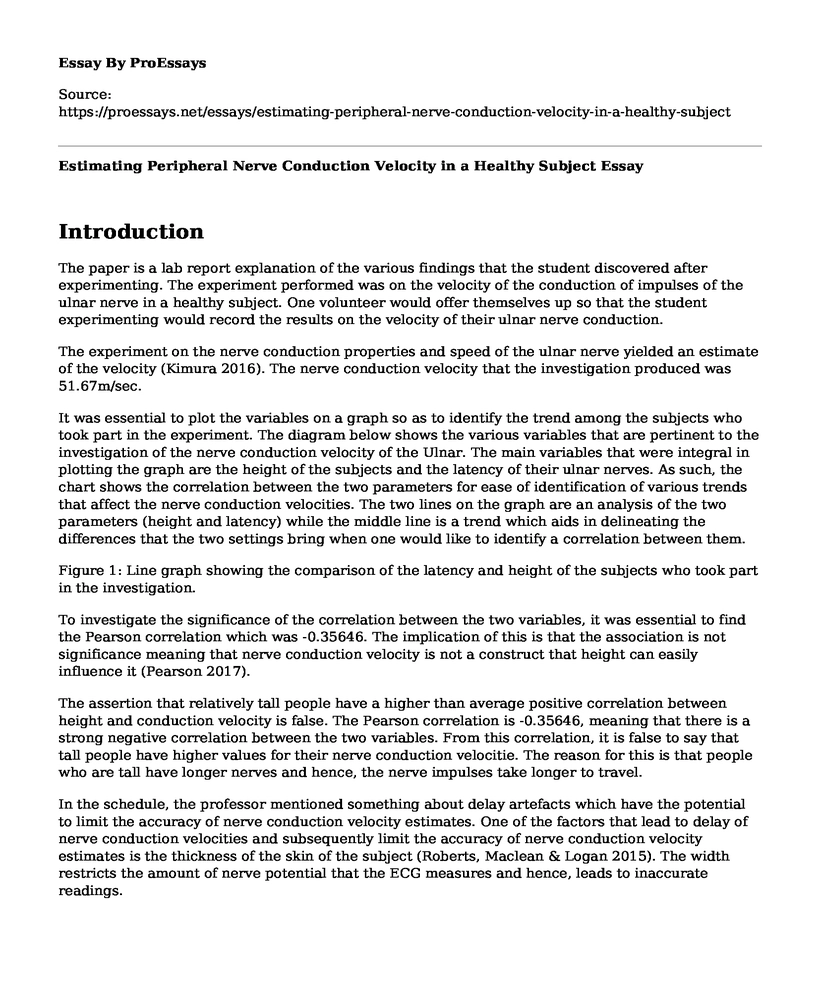Introduction
The paper is a lab report explanation of the various findings that the student discovered after experimenting. The experiment performed was on the velocity of the conduction of impulses of the ulnar nerve in a healthy subject. One volunteer would offer themselves up so that the student experimenting would record the results on the velocity of their ulnar nerve conduction.
The experiment on the nerve conduction properties and speed of the ulnar nerve yielded an estimate of the velocity (Kimura 2016). The nerve conduction velocity that the investigation produced was 51.67m/sec.
It was essential to plot the variables on a graph so as to identify the trend among the subjects who took part in the experiment. The diagram below shows the various variables that are pertinent to the investigation of the nerve conduction velocity of the Ulnar. The main variables that were integral in plotting the graph are the height of the subjects and the latency of their ulnar nerves. As such, the chart shows the correlation between the two parameters for ease of identification of various trends that affect the nerve conduction velocities. The two lines on the graph are an analysis of the two parameters (height and latency) while the middle line is a trend which aids in delineating the differences that the two settings bring when one would like to identify a correlation between them.
Figure 1: Line graph showing the comparison of the latency and height of the subjects who took part in the investigation.
To investigate the significance of the correlation between the two variables, it was essential to find the Pearson correlation which was -0.35646. The implication of this is that the association is not significance meaning that nerve conduction velocity is not a construct that height can easily influence it (Pearson 2017).
The assertion that relatively tall people have a higher than average positive correlation between height and conduction velocity is false. The Pearson correlation is -0.35646, meaning that there is a strong negative correlation between the two variables. From this correlation, it is false to say that tall people have higher values for their nerve conduction velocitie. The reason for this is that people who are tall have longer nerves and hence, the nerve impulses take longer to travel.
In the schedule, the professor mentioned something about delay artefacts which have the potential to limit the accuracy of nerve conduction velocity estimates. One of the factors that lead to delay of nerve conduction velocities and subsequently limit the accuracy of nerve conduction velocity estimates is the thickness of the skin of the subject (Roberts, Maclean & Logan 2015). The width restricts the amount of nerve potential that the ECG measures and hence, leads to inaccurate readings.
Conclusion
Neurological disorders that present with a significant reduction in nerve conduction velocity are numerous. One of these disorders is Multiple Sclerosis (MS). It is an unpredictable disease that affects the central nervous system disrupting the flow of nerve impulses from the brain to the other peripheral centers. As such, it leads to a significant reduction in the nerve conduction velocity of the affected nerves. The main clinical features are as follows; the presence of seizures which come on and off, feelings of paralysis, and numbness and tingling in various parts of the body. The clinical symptoms vary for several people and hence, it is not easy to find more than one case that presents with the same symptoms (Briggs, Yu, Davis, Jiangyang, Fu, Parrott & Ontaneda 2019).
References
Briggs, F. B., Yu, J. C., Davis, M. F., Jiangyang, J., Fu, S., Parrotta, E., ... Ontaneda, D., 2019. Multiple sclerosis risk factors contribute to onset heterogeneity. Multiple Sclerosis and Related Disorders, 28, 11-16. doi:10.1016/j.msard.2018.12.007
Pearson., 2017. Correlation and Regression - Pearson. doi:10.4135/9781526400086
Kimura, J., 2016. Nerve conduction studies. Oxford Medicine Online. doi:10.1093/med/9780199688395.003.0006
Roberts, G. L., Maclean, A. D., & Logan, A. J., 2015. Ulna Nerve Decompression at the Elbow in Patients with Normal Nerve Conduction Tests. Hand Surgery, 20(02), 260-265. doi:10.1142/s0218810415500215
Cite this page
Estimating Peripheral Nerve Conduction Velocity in a Healthy Subject. (2022, Dec 18). Retrieved from https://proessays.net/essays/estimating-peripheral-nerve-conduction-velocity-in-a-healthy-subject
If you are the original author of this essay and no longer wish to have it published on the ProEssays website, please click below to request its removal:
- Course Work Example: Definition and Scope of Practice of Advanced Practice Registered Nurses
- Research Proposal Example: Impact of Medical Procedure Prices on Society
- Article Analysis Essay on Chemistry Current Event
- Pharmacotherapy for Neurological Disorders Essay
- Essay Example on Homelessness: Ignored Crisis Amidst COVID-19 Pandemic
- Paper Example on Beating COVID-19: Safe Practices for Prevention
- Cancer: A Global Threat - Exploring Causes, Theories, and Cures - Paper Sample







